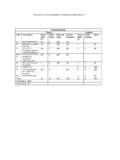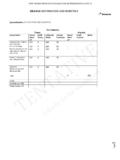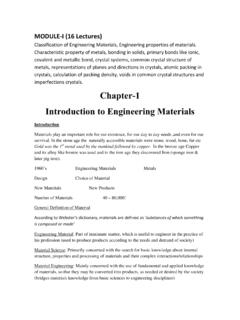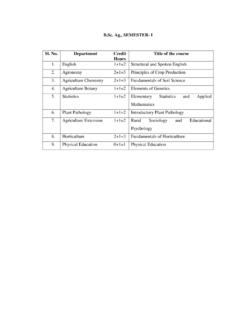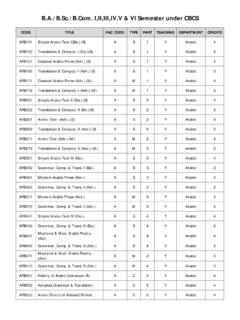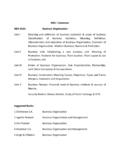Transcription of First Semester B.Tech Syllabus for Admission Batch …
1 First Semester Syllabus for Admission Batch 2016 -17. First Semester Theory Practical Code Course Name Hours/ Credit University Internal Hours/ Credit Marks Week Theory Marks Evaluation Week Practical L/T L/T. BS Applied Mathematics-I 3-1 4 100 50 - - - BS Applied 3-0 3 100 50 2 1 50. Chemistry/Applied Physics ES Basics of Mechanical 3-0 3 100 50 2 1 50. Engineering / Basics of Civil Engineering MC & Environmental Studies 3-0 3 100 50. GS & Health Care Engineering/. Professional Ethics HS English Communication 3-0 3 100 50 2 1 50. Skill ES Computer Lab 4 2 100. ES Engineering Workshop/ 2-0 1 - 50 4 2 100. Engineering Graphics lab. Total 18 17 500 300 14 7 400. Total Marks: 1200. Total Credits: 25. 1. Page First Semester Syllabus for Admission Batch 2016 -17. APPLIED MATHEMATICS-I. 1st Semester Module-I (13 Hours ). Calculus: Asymptote, Curvature , Partial differentiation, Taylor's theorem for function of two variable, Maxima and Minima for function of two variables.
2 Module II (12 Hours). Differential Equation-1. Differential Equation: First order differential equations, Separable Equation, Exact differential equation, Linear differential equation, Bernoulli's equation and application to Electrical circuits. Differential Equation-II. Linear differential equation of second and higher order, Homogeneous equation with constant co-efficient, Euler-Cauchy equations, Solution by undetermined co-effficient, Solutions by variation of parameters, Modeling of electric circuits Module-III (10 Hours ). Series solution of differential equations, Power series method, Legendre equation and Legendre polynomials, Linear algebra, Matrices, Vectors, Determinants, System of linear equations, Module-IV (10 Hours ). Eigen values and eigen vectors, Symmetric and skew-symmetric matrices, Orthogonal matrices, Complex matrices, Hermitian and skew-Hermitian matrices, Unitary matrices and similarity of matrices. TextBooks: 1. Differential Calculus by Santi Narayan and Mittal, Chapters 14, 15 Publication 2.
3 Advanced Engineering Mathematics by E. Kreyszig, Tenth Edition , Willey 3. Higher Engineering Mathematics by , Chapter , , McGraw Hills Education References: 1. English Mathematics by paland s Bhunia, Oxford Publication 2. Ordinary and Partual Differential equations by J. Sihna Ray and S Padhy, Kalyani Publishers 3. Advance Engineering Mathematics by 'NEIL, CENGAGE. 2. Page First Semester Syllabus for Admission Batch 2016 -17. APPLIED PHYSICS. Module-I (07 Classes). Classical Dynamics Principle of virtual work, De-Alembert Principle, Action principle, Langrage equation of motion and its application to Simple Harmonic oscillator. Velocity dependent potential. Oscillation & Waves Simple Harmonic Oscillation, damped harmonic oscillation, Forced oscillator, resonance, coupled oscillation, concept of wave and wave equation. OPTICS. Concept of interference, two source interface pattern, Bi-prism, Michelson Interferometer &. measurement of wavelength. Diffraction: Hugen's principle, Fresenel & Frauhoper's diffraction, Zone plate.
4 Module-II (07 Classes). Solid State Physics Crystalline and amorphous solid, unit cell, Miller Indices, Reciprocal lattice, Bragg's law, Brillouin's zone, concept of fermions, Maxwell-Boltzmann, Fermi-Dirac and Bose-Einstein distribution function (only statement and formula), Concept of Fermions and Bosons. Classification of materials: metals, semiconductor and insulator in terms of band theory LASER and Fibre Optics: principle and application -stimulated emission, population inversion, Lasing material (solid and gas), He-Ne laser, Rubi- LASER, Application of LASER (Engineering Application), Principle of optical fibre and its application to communication. Module-III (08 Classes). Electromagnetism- Student will be familiarized with some basic used in vector calculus prior to development of Maxwell's electromagnetic wave equations. No proof of theorems and laws included in this unit expected- statement and interpretation should sufficient. a) Vector calculus: gradient of scalar field, divergence, curl of vector field (Only Physical significance) Gauss divergence theorem, Stoke's theorem, Green's theorem (Only Statements).
5 B) Gauss's law of electrostatics in free space and in a medium(Only statements)electric displacement( D)magnetic Induction (B),Amperes circuital law (Only statements), displacement current, Faraday's law of electromagnetic induction(Only statements). Module-IV(08 Classes). Quantum Physics: Elementary concepts of quantum physics formulation to deal with physical systems. a) Need for Quantum physics-Historical overviews, Particle aspects of radiation-Black body radiation, photoelectric effect, Compton scattering, pair production.( No derivations), Wave aspect of particles- matter wave, de Broglie Hypothesis, Heisenberg Uncertainty principles- 3. Page Statement, Interpretation and example First Semester Syllabus for Admission Batch 2016 -17. b) Basic features of Quantum mechanics- Transition from deterministic to probabilistic, States of system- Wave function, probability density, superposition principle, observables and operators, expectation values. Schrodinger equation-Time dependent and time independent, wave packets.
6 Text Books: 1. Principle of Physics Vol. I & Vol. II by Md. M. Khan & S. Panigrahi (Cambridge Univ. Press). 2. Engineering Physics by Joshi, Mc Graw Hill 3. Engineering Physics by Bhattacharya and Poonam Tandon, Oxford University Press Reference Book: 1. Quantum Mechanics by Powel & Craseman. 2. Optics- A. K. Ghatak 3. Electricity & Magnetism : Purecell 4. Introduction to Electrodynamics- David J. Griffiths, PHI Publication 5. Concepts of Modern Physics Arthur Beiser. 6. Engineering Physics- and P. Pattojoshi, Scitech Pub. 7. Concepts in Engineering Physics-I Md. N. khan, Alok Publication. 8. Physics-I for engineering degree Swain and 9. An Introduction to Machanics by & R. Kolenkow, TMH. 4. Page First Semester Syllabus for Admission Batch 2016 -17. APPLIED PHYSICS LABORATORY. A student is expected to perform ten experiments form the list given below. 1. Determination of Young's modulus by Searle's method. 2. Determination of Rigidity modulus by static method. 3.
7 Determination of surface tension by capillary rise method. 4. Determination of acceleration due to gravity by Bar / Kater's pedulum. 5. Determination of unknown resistance using meter bridge. 6. Determination of wave length of light by Newton's ring apparatus. 7. Determination of grating element of a diffraction grating. 8. Plotting of characteristic curve of a PN junction diode. 9. Plotting of characteristic curves of BJT. 10. Verification of laws of vibration of string using sonometer. 11. Determination of wavelength of laser source by diffraction rating method. 12. Study of Hall Effect. 13. Study of RC circuit. 14. Determination of Young's modulus by bending of beams. 15. Michelson Interferometer. 16. Determine of reduction factor of the given tangent galvanometer and horizontal component of earth's magnetic field by using tangent galvanometer. 5. Page First Semester Syllabus for Admission Batch 2016 -17. APPLIED CHEMISTRY. Course Objectives: (1) To understand the basics of molecular interactions.
8 (2) Introductory idea about organometallics and their catalytic applications. (3) Basics of fuels an corrosion chemistry. Module I: Quantum Chemistry and Spectroscopy: Basic concepts and postulates of quantum mechanics. Introduction to Schrodinger Wage Equation. Particle in a box: Energy levels, quantum members and selection rule. Spectroscopy: Lambert Beer's Law, Principles and applications of UV-Visible Molecular Absorption Spectroscopy; Chromophores, applications to colorimetry. Effect of conjugation on chromophores, Absorption by aromatic systems, Introductory idea on Rotational and Vibrational Spectroscopy-Principles and application to diatomic molecules. [7 Classes]. The phase rule: Statement of Gibb's phase rule and explanation of the terms involved, Phase diagram of one component system water and sulfur system, Condensed phase rule, Phase diagram of two component system Eutectic Bi-Cd system. [3 Classes]. Module II: (10. classes). Organometallics: Introduction to organometallics, EAN rule; classification, nomenclature and characteristics of organometallic compounds.
9 Applications of organometallic compounds and catalyst in alkene isomerization hydrogenation and hydroformylation (detail mechanisms are to be excluded). [10. Classes]. Module III: Fuels: Classification of fuels, calorific value. (Determination by Dulong's formula), and Liquid fuels: Classification of petroleum, Refining of petroleum, Cracking, Knocking and anti knocking, cetane and octane numbers. Unleaded petrol, synthetic petrol, power alcohol. Gaseous Fuel: Producer gas, Water gas, LPG, CNG, Kerosene gas, Combustion calculation. [10 Classes]. Modlule-IV (6classes). Corrosion: Electrochemical theory of corrosion, galvanic series, Types of corrosion; Differential metal corrosion, Differntial aeration corrosion (Pitting and water line corrosion), Stress corrosion (caustic embrittlement in boilers), Factors affecting, Metal coatings Galvanizing and Timing, Corrosion inhibitors, cathodic protection. 6. Page First Semester Syllabus for Admission Batch 2016 -17. Text Books: 1.
10 Text Book in Applied Chemistry by A. N. Acharya and B. Samantaray, Pearson India. 2. Introductory to Quantum Chemistry by A. K. Chandra. , 4th Edition, Mcgraw Hill Education. 3. Fundamentals of Molecular & Spectroscopy by Banwell, Tata McGraw Hill Education. 4. Physical Chemistry by Gordon M. Barrow, McGraw-Hill 5. Engineering Chemistry, 12th Edition, Author: Wiley India Editorial Team Publishers Wiley. 6. Engineering Chemistry: Fundamentals and Applications. Shikha Agarwal. Cambridge University Press. 7. Engineering Chemistry, Jain and Jain, Dhanpat Rai Publiation. Reference Books: 1. Inorganic Chemistry by Donald A. Tarr, Gary Miessler, Pearson India, Third Edition. 2. Quantum Chemistry by Ira N. Levine, Pearson 7th Edition. 3. Molecular Spectroscopy, Ira N. Levine, John Wiley and Sons 4. Modern Spectroscopy A Molecular Approach, by Donald McQuarrie and John Simon, published by University Science Books. 5. Inorganic Chemistry by W. Overton, Rounk and Armstrong, Oxford Univesity Press, 6th edition.
